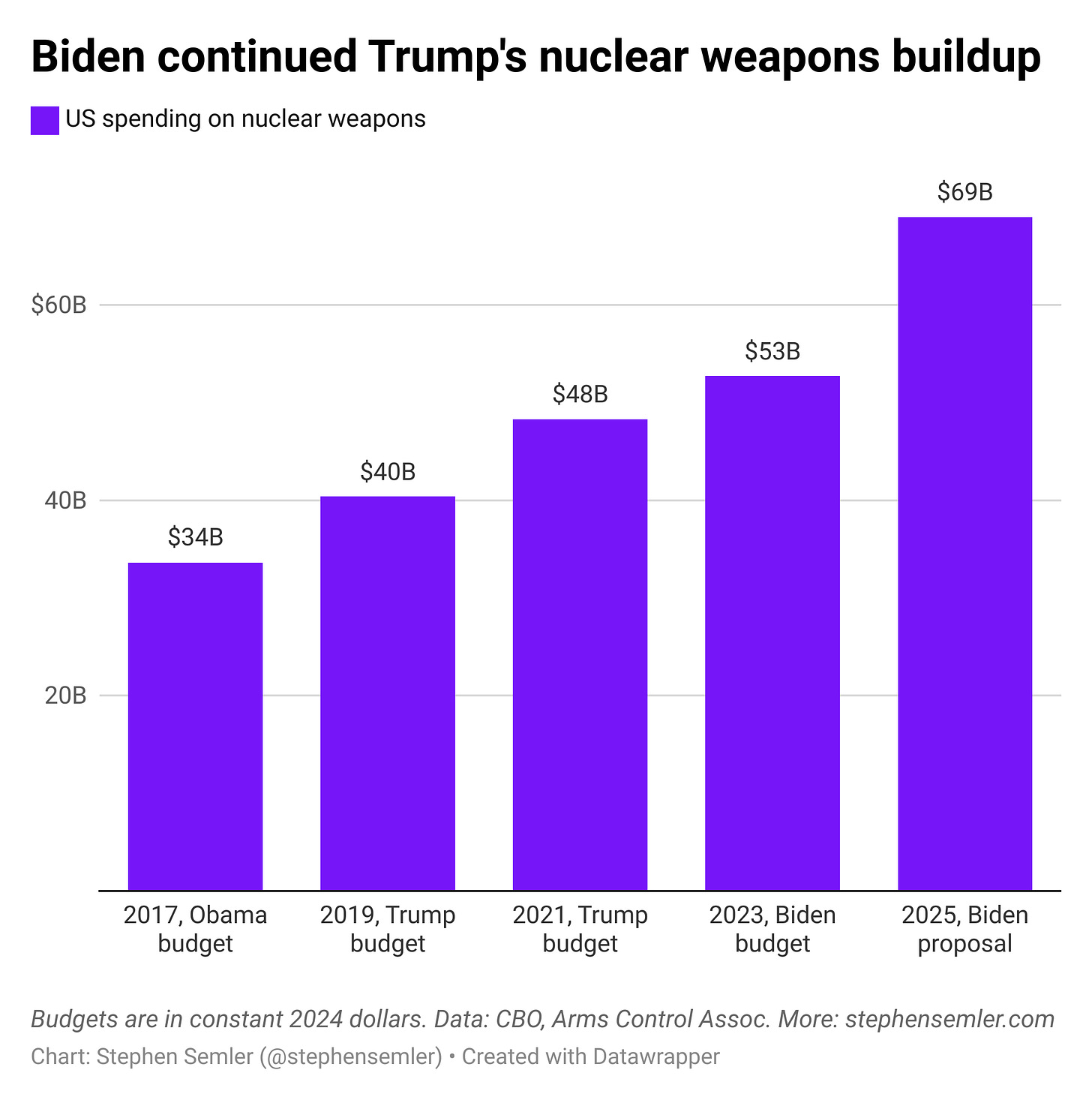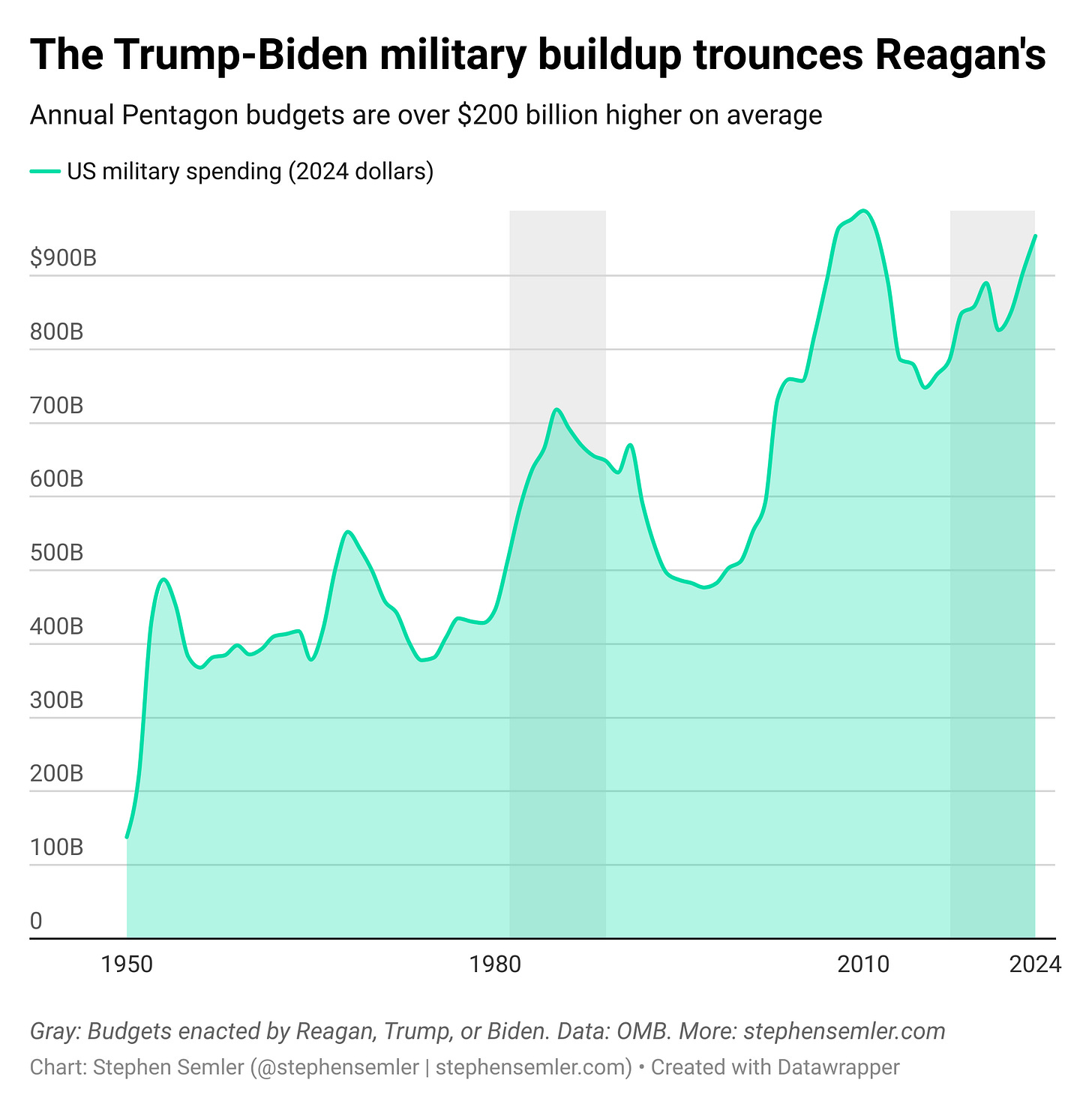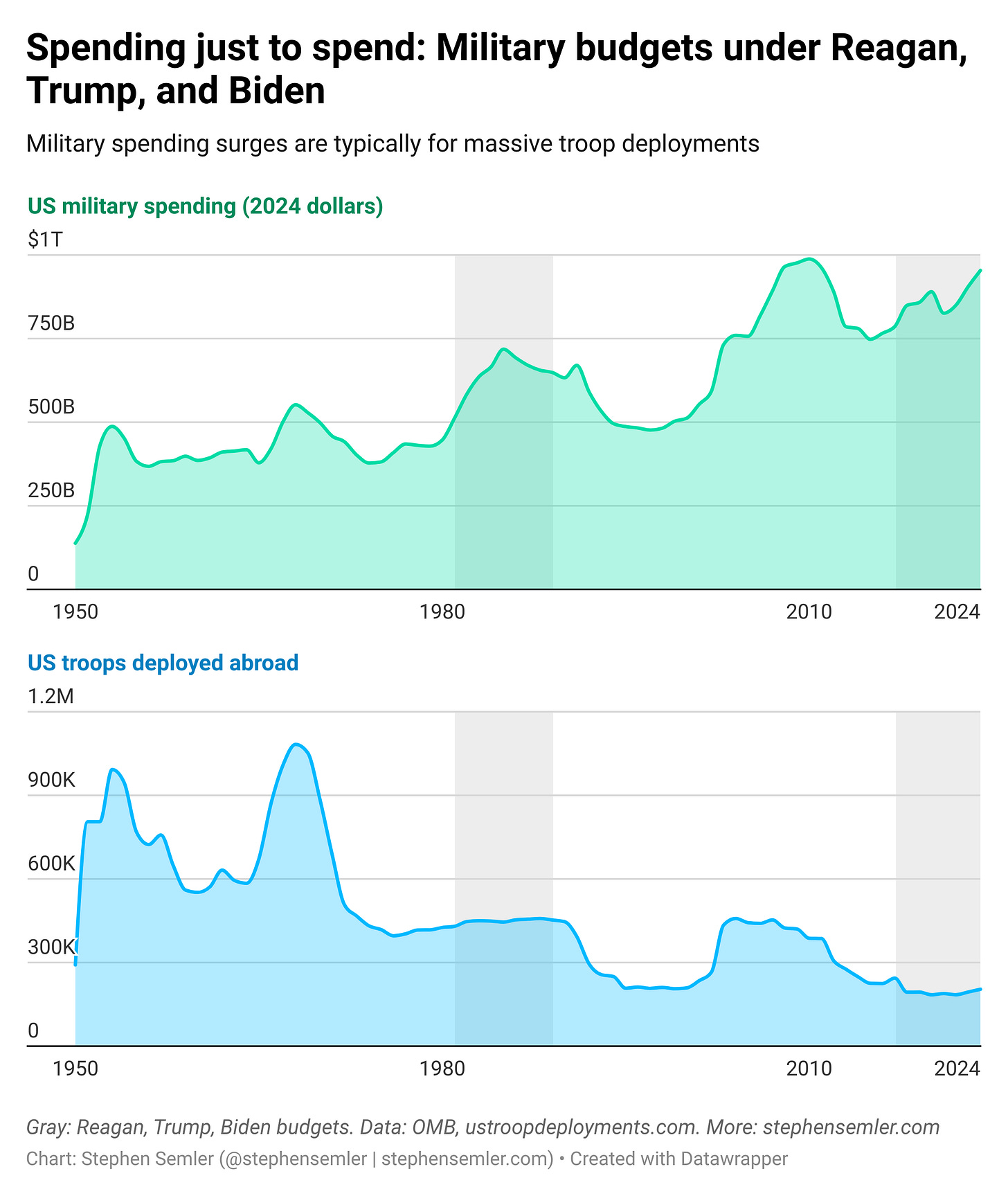*Trump just endorsed the House GOP’s plan to advance his domestic agenda. Want to know more about that plan? I wrote about it last week — see Polygraph n°290.
*Thank you Ben C., Jeff, Jessica S., and Joshua R. for becoming Polygraph’s latest VIPs! Paid subscribers help raise class consciousness and get access to exclusive content. Join them here:
Situation
The Washington Post appeared to break some remarkable news this week: Pentagon Chief Pete Hegseth reportedly directed his department to come up with a plan to cut 8% of projected annual military spending in each of the next five years. That’s striking because the Pentagon is among the last places to expect an administration of either party to seek dramatic spending reductions.
That’s not what happened, though. Hegseth never ordered any cuts; he merely wants to shift funding from some military programs to others. That’s not cutting the Pentagon budget; that’s reshuffling it.
The Washington Post — among other outlets — ultimately decided not to let facts get in the way of a spicy headline. The original article (see the first excerpt below) had “sweeping budget cuts” in the headline. The amended version (see the second excerpt) still uses “sweeping budget cuts” in the headline but admits in the text directly underneath that the Trump administration didn’t actually order any cuts — just reallocations. And you know as well as the Post does that moving money around within the Pentagon budget isn’t the same as taking money out of it, and that “cuts” only describes the latter.
Where Trump actually stands on military spending
Part of the reason the Washington Post report appeared plausible is because of the president’s recent comments. Arms industry stocks dropped sharply last week after Trump said he aimed to get major powers — including the United States — to shrink their military budgets and nuclear arsenals. “One of the first meetings I want to have is with President Xi of China and President Putin of Russia, and I want to say, ‘Let’s cut our military budget in half.’ And we can do that,” Trump said. “We’re going to have them spend a lot less money. We’re going to spend a lot less money.” he added. “We’re all spending a lot of money that we could be spending on other things that are…much more productive.”
Trump also stated that he and Putin agreed to pursue denuclearization “in a very big way,” adding, “There’s no reason for us to be building new nuclear weapons. We already have so many…You could destroy the world 50 times over, 100 times over. And here we are, building new nuclear weapons, and they’re building nuclear weapons.” Actually using those weapons means “probably oblivion,” Trump said.
There are two things to grapple with here:
Trump’s calls to reduce military spending, nuke stockpiles, and tensions with rival powers are among the most sensible ideas you’ll hear come out of the Oval Office.
Trump’s commitment to achieving those goals isn’t exactly credible, considering how his first term went.
Joe Biden would never say what Trump recently did — he took too much pride in inflating the Pentagon budget and nuclear arsenal in the name of great power competition. But Biden’s policies were largely extensions of Trump’s. For example, after Trump ramped up nuclear weapons spending in his first term, Biden doubled down on the same insane practice for the next four years.
The concern now is that Trump will pick up right where Biden left off, just as Biden picked up where Trump left off. The same goes for military spending more broadly.
Where the US stands on military spending
Washington appears to be under the false impression that more military spending means more security, especially under the last two presidents. Biden called military budgets “investments in our national security,” as if security simply falls out of the Pentagon if you shove enough money into it. Trump embraced the same logic; his 2018 National Defense Strategy declared, “The surest way to prevent war is to be prepared to win one,” requiring “consistent, multiyear investment to restore warfighting readiness and field a lethal force.” The message was clear: big military budgets bring peace.
That isn't true. The stated goal of increased military spending has been to beat back (“outcompete”) rival powers. But that strategy has failed. Trump’s buildup didn’t deter Russia from invading Ukraine — and Russia’s poor military performance only highlighted how much the US had overestimated (and over-budgeted for) the threat posed by its conventional forces. Meanwhile, Biden’s Pentagon spending spree helped dramatically escalate tensions with China.
Even the link between military spending and military capabilities is tenuous, thanks to rampant contractor profiteering, congressionally earmarked vanity projects, and the Pentagon’s inability to pass an audit.
In Congress, both parties are on autopilot, rubber-stamping Pentagon budget increases without considering the consequences, the costs, or public opinion. The assumption that military spending (an act) equals security (a desired outcome) appears baked into the congressional budget process. It’s military spending for the sake of military spending.
The numbers tell the story
As the graph below shows, today’s Pentagon budget, adjusted for inflation, just about matches the peak spending levels of the Iraq and Afghanistan wars. It's no coincidence that military spending surges during particularly idiotic and destructive moments in US foreign policy history.
Still, Senate Armed Services Committee Chair Roger Wicker (R-MS) wants to lock in even higher spending, proposing a floor of 5% of GDP — a completely arbitrary, dangerous, and astronomically expensive target. (Notably, Wicker took nearly $1 million from arms industry donors last election cycle, more than any other senator.) His proposal, “21st Century Peace Through Strength,” is a nod to one of Ronald Reagan’s favorite slogans.
The Trump-Biden military buildup far exceeds Reagan’s legendary 1980s buildup — annual Pentagon budgets under the last two administrations surpass those under Reagan by over $200 billion on average.
^Alt text for screen readers: The Trump-Biden military buildup trounces Reagan’s. Annual Pentagon budgets are over $200 billion higher on average. This green line graph shows military spending over time in constant dollars. Annual budgets enacted by Reagan, Trump, or Biden are highlighted. Data: Office of Management and Budget.
Of the post-World War II military buildups, Reagan’s most closely resembles the current one. There are many similarities, like how both involve cutting social welfare. But what really stands out is their shared spending-for-the-sake-of-spending approach to the Pentagon budget.
Like the current buildup, Reagan’s didn’t deliver security as promised. In fact, it made everyone less safe. Reagan’s rapid military escalation inflamed tensions between the US and the Soviet Union, undoing the détente efforts that had started under Kennedy in 1963. “Peace through strength” reignited an arms race.
Corporate profits soared during both buildups, but whether either improved military effectiveness that much — the most basic expectation — is up for debate. The demand Reagan’s budgets put on the arms industry far outstripped supply. Weapons companies capitalized on this, charging inflated prices. Reagan bought more missiles, aircraft, and tanks than Jimmy Carter, but paid 91%, 75%, and 147% more for each, respectively. This cost explosion meant Reagan’s soaring budget wasn’t improving military capabilities nearly as much as expected — which is why it became known as a “spend-up” (as opposed to a build-up — get it?!)
Beyond their similarities, the Reagan and Trump-Biden buildups are unique in that they introduced wartime levels of military spending into a context where the US wasn’t actually fighting in a major war. I highlight this in the graph below, where I’ve stacked the chart above on top of another showing US troop deployments from 1950 onward. You’ll notice that surges in military spending accompany surges in troop deployments — except under Reagan, Trump, and Biden. So, what exactly did we pay for?
^Alt text for screen readers: Spending just to spend: Military budgets under Reagan, Trump, and Biden. Military spending surges are typically for massive troop deployments. This two-part graph shows U.S. military spending from 1950 onwards in the top portion and the number of U.S. troops deployed abroad from 1950 onwards in the bottom section. They tend to rise and fall in time, but didn’t under Reagan, Trump, and Biden. Data: Office of Management and Budget, UStroopdeployements.com
SPECIAL THANKS TO: Abe B., Alan F., Amin, Andrew R., AT., BartB., BeepBoop, Ben, Ben C.,* Bill S., Bob N., Brett S., Byron D., Chris, Chris G., Cole H., D. Kepler, Daniel M., David J., David S.,* David V.,* David M., Elizabeth R., Errol S., Foundart, Francis M., Frank R., Gary W., Gladwyn S., Graham P., Griffin R., Hunter S., Irene B., Isaac, James H., James N., Jcowens, Jeff, Jennifer, Jennifer J., Jessica S., Jerry S., Joe R., John, John, John A., John K., John M., Jonathan S., Joseph B., Joshua R., Julia G., Katrina H., Kheng L., Lea S., Leah A., Leila CL., Linda B., Linda H., Lindsay, Lindsay S.,* Lora L., Mapraputa, Marie R., Mark L., Mary Z., Marty, Matthew H.,* Megan., Melanie B., Michael S., Mitchell P., Nick B., Noah K., Norbert H., Omar A., Omar D.,* Peter M., Phil, Philip L., Rosemary K., Sari G., Scarlet, Silversurfer, Soh, Springseep, TBE, Teddie G., Theresa A., Themadking, Tim C., Timbuk T., Tony L., Tony T., Victor S., Wayne H., William P.
* = founding member








